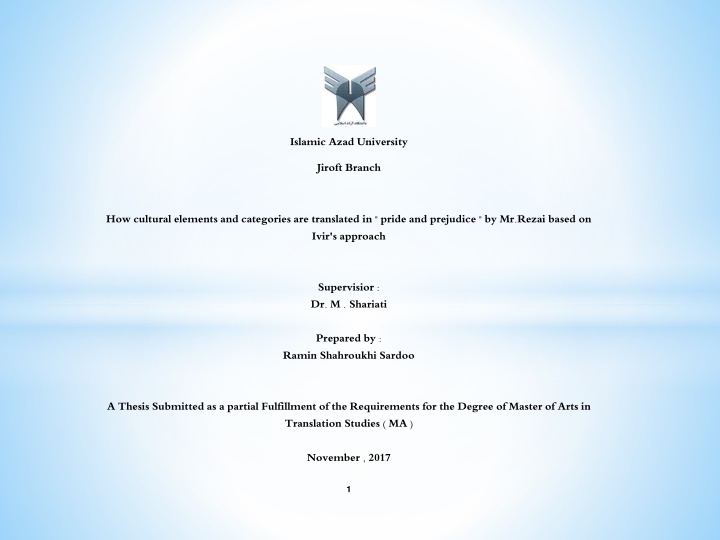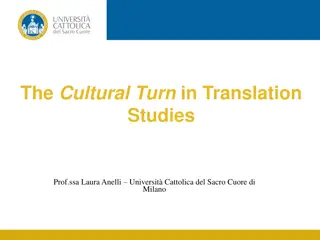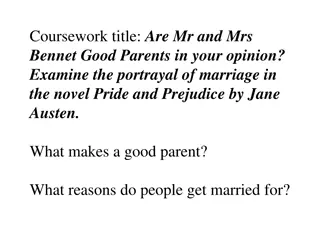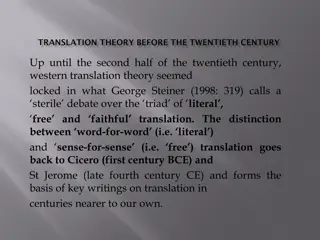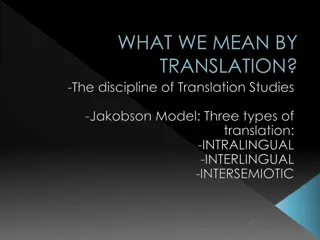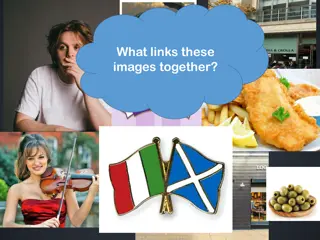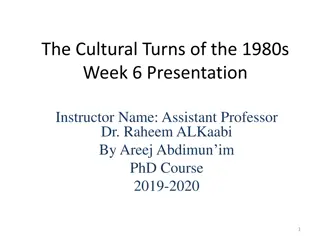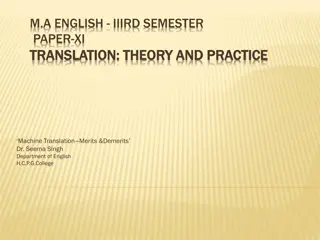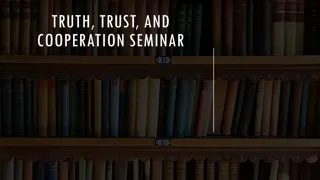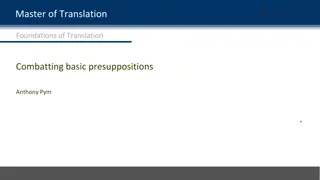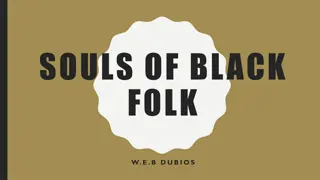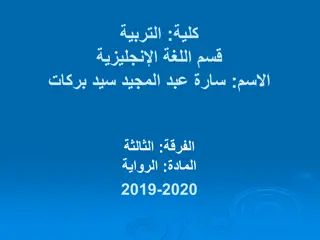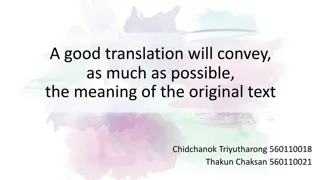Cultural Elements in 'Pride and Prejudice' Translation" (70 characters)
This study analyzes the translation of cultural elements in Jane Austen's "Pride and Prejudice" by Mr. Rezai, exploring how cultural categories are conveyed through translation strategies according to Ivir's approach. The research examines the challenges and successes in transferring specific cultural concepts between languages, shedding light on the role of translators as mediators in bridging cultural gaps. The investigation aims to enhance understanding of linguistic and cultural nuances in literary translations, highlighting the significance of cultural elements in cross-cultural communication. (498 characters)
Uploaded on Mar 04, 2025 | 0 Views
Download Presentation

Please find below an Image/Link to download the presentation.
The content on the website is provided AS IS for your information and personal use only. It may not be sold, licensed, or shared on other websites without obtaining consent from the author.If you encounter any issues during the download, it is possible that the publisher has removed the file from their server.
You are allowed to download the files provided on this website for personal or commercial use, subject to the condition that they are used lawfully. All files are the property of their respective owners.
The content on the website is provided AS IS for your information and personal use only. It may not be sold, licensed, or shared on other websites without obtaining consent from the author.
E N D
Presentation Transcript
Islamic Azad University Jiroft Branch How cultural elements and categories are translated in " pride and prejudice " by Mr.Rezai based on Ivir's approach Supervisior : Dr. M . Shariati Prepared by : Ramin Shahroukhi Sardoo A Thesis Submitted as a partial Fulfillment of the Requirements for the Degree of Master of Arts in Translation Studies ( MA ) November , 2017 1
Introduction * When countries ,nations , goverments want to have a relationship with each other , they must know their languages and cultures.Translation is a try to make possible thier communication . Translator play a role as a mediator.He/She must try to convey the massage of SL to TL without haveing any gain or loss.Sometimes , it is possible to translate ST to TT without any problems, but sometimes the cultural gapes between the countries make translation hard or even impossible ,specially when they are geographically far from each other. Venuti (1996 : 18) mention that " the aim of translation is to bring back a cltural other as the same , the recognizable , even the familiar ." 2
* Sometimes or even always the cultural differences between the countries make hard or even impossible translating cultural words or phrases .These cultural differences are due to goegraphical, social , political and ecconomical differences between the nations or governments. .According to Newmark (1988: 7) " translation is a craft consisting in the attempt to replace a written message and /or statement in one language by the same message and /or statement in another language ." So translation has not just been translating lingistical items it often contains transfering cultural elements .The present research is a study on these cultural specific items bethween the languages. 3
* The Novelty of Research Several works and theses have been done on literary texts.Some papers have also analays cultural specific items in some novels but this is the first time that a study has been done on CSCs in Novel " pride and prejudice " written by Jain Austen , translated by Reza Rezai. 4
* Objective of the research This research has been studing cultural _ elements in Novel " pride and prejudice " written by Jane Austen and translated by Mr . rezai . In other word the aim of research is to investigate whether the translator as a mediator was successful in transfering cultural _ specific _ concepts from original Novel " pride and prejudice " to the translated one . The cultural _ items have been categoriesed based on Newmark 's clasification ( 1988 , pp . 94- 100) and analayzed based on Ivir 's model ( 1987 ) of translation strategies . 5
* Research Questions The present research tried to answer to several questions in related to the cultural specific items which are used in Novel " pride and prejudice " by Jane Austen ,the strategies used by Mr. Razai in translating these cultural specific concepts (CSCs) .Questions are as follow : 1. what is the predominant cultural element in Novel " pride and prejudice"? 2.what is the predominant strateges in translating cultural items? 3.Is the combined strategy the best procedure to translate ST to TT? Hypotheses of the Research Hypotheses of the present research are : 1.The predominant cultural item is material culture which is on of five categories which Newmark defined for cultural elements. 2. the predominant strategy for translating CSCs is literary one. 3.the best and common strategy to translate cultural items from ST to TT is combined and simultaneous one. 6
* Method of the research In the present research , the researcher has firstly studied the original and translated novel " pride and prejudice " to find out the cultural items which have been used for four main characters in novel ( Jane , bingley , Elizabeth , Darcy) . Then these cultural concepts have been classified based on Newmark' s classification(1988 ) of cultural items and listed in several tables along with their percentage . Afterwards the researcher has investigated which procedures and strategies have been used by translator to translate these cultural _ specific _ concepts based on Ivir 's approach and which strategy has been used the most. 7
* 3.3 Materials This is a qualitative case study research with a descriptive feature . The case study is the English literary masterpiece ' Pride and Prejudice ' written by Jane Austen ( 1797 1813 ) , which is the only case utilized in this study . This Novel is selected for it's deep immersion in English Culture in that era . It has been translated by Mr. Rezai into Persion under the title of in 2000 . All used specific items are the samples of this research , i.e. no specific sampling is applied . 8
* 3.4 Procedure The data , cultural specific items , extracted from the corpus , pride and prejudice , written by Jane Austen . since , determining which words shall be called cultural specific items is a difficult task , the Newmark's model is utilized to identify these cultural items .In table below , table 1 , researcher introduced Newmark's model of cultural items with at least one example for each section in origenal text and it's translation .The cultural item for each part is underlined . It should also be mentioned , the cultural items mining from the corpus are only the words used by four main characters of Novel ( Elizabet , Darcy , Jane , Bingley ) . 9
* Table 3. 1 Newmark's classification of Culture spesific items Ecology Material Culture Food Clothes House Transport Town and countries Social Culture Work Leisure Social Organizations Poltical and Administrative Religous Artistic Gestures and Habits 10
* 3.4.1 Examples are : 3.4.1. 1. Ecology : This item are related to Elizabeth . - were got into the ' Is this all ? cried Elizabeth . ' I expected at least that the pigs garden , and here is nothing but Lady Cathrine and her daughter ! ' " ! , " : 11
* 3.4.1.2. Material Culture : This items are about town and kind of clothes used by Elizabeth. ' Yes ' He is a man of very large property in Derbyshire , i understand . ' : 12
* 3.4.1. 3. Social Culture : Then , the two third he danced with Miss King , and the two fourth with Maria Lucas , and the two fifth with Jane again , and the two sixth with Lizzy , and the Boulanger , , , , 13
* 3.4.1.4 . Social Organizations : Last Christmas you were afraid of his marrying me , because it would be imprudent , . 14
* 3.4.1. 5 . Gestures and Habits : Mr . Darcy corroborated it with a bow , and was begining to determine not to fix his eyes on Elizabeth . 15
* Table3. 2 Ivir's model for translating CSIs Borrowing toTT Definition Translator defines a word , experation , or cocept Of ST into TT Literal Translation It is the most common procedure in translating Experations and words from ST to TT for it is Faithfull to ST Substitution Translator use an experation similar to ST's , but Not exactly the same Lexical Creation Translator produces a new word or experation in Target text Omission Translator deletes a word or experation of ST in TT Addition Translator addes a word or experation to TT . 16 Translator imports one experation from ST
* 3.4.2 Example for translation strategies based on Ivir's model extracted from ST and TT : 3.4.2.1. Borrowing : Table Borrowing 1 Number 1 ST ' Yes , she will remain there till Christmas . '( p. 229 ) , 25 Gloss . TT . (P.390 ) 17
* 3.4.2.2. Definition : Table Definition 1 Number 3 ST Then the two third he danced with Miss King , and the two fourth With Maria Lucas , and the two fifth with Jane again , and the two Sixth with Lizzy , and the Boulanger -----' (p. 8 ) Gloss TT , , , . , ( p. 23 ) 18
* 3.4.2.3. Literal Translation : Table Literal 1 Number 7 ST Netherfield is taken by a young man of large fortune from The north of england . ( p.1 ) Gloss TT . (p. 12 ) 19
* 3.4.2.4. Addition : Table Addition 1 Number 10 ST Both changed colour , one looked white , the other red .(P.49) , - , , , Gloss , , TT (p. 91 ) 20
* 3.4.2.5. Omission : Table Omission 2 Number 13 ST Elizabeth obeyed , and running into her own room for her parasol , , Gloss . TT . 21
* 4.4 Research's Data The researcher collected the data obtained from close study of ST and TT to analyze and examine how CSIs are rendered from English to Persian . Therefore , The number of Translation strategies used by translator , Mr. Rezai in translating CSIs are listed below : 1. Applying Literal Translation for all four Characters in novel : 70 items 2. Applying Borrowing translation for all characters in novel : 46 items 3. Applying Definition Translation for all characters in novel : 6 items 4. Applying Substitution Translation for all Charecters in novel : 13 items 5. Applying Creation Translation for all Charecters in novel : 0 item 6. Applying Omission Translation for all Characters in novel : 9 items 7. Applying Addition Translation for all Characters in novel : 21 items 22
* Pie chart 4.1 : The percentage of each translation Method Omission 5% Addition 13% Creation 0% Borrowing 27% Substitution 8% Definition 4% Literal 43%
* This Pie chart pointed up the translator used Ivir's strategies with this percentages to translate CSIs taken out from ST : %43 Literal , % 27 Borrowing , % 13 Addition , % 8 Substitution , % 5 Omission , and % 4 Definition . The data obtained from this Pie chart showed the most frequent strategies used for translating these CSIs are Literal and Borrowing translation with %43 and %27 . Moreover , applying Literal and Borrowing translation strategies with the most percentages demonstrated the translator was going to be faithful to ST . He more or less tried to make familiar the target reader to ST and it's culture . 24
* Conclusion This project examined the use of suggested strategies for translation from English to Persian . The evidence suggests, however, that religious, cultural and literary differences make it difficult to achieve complete word-for-word parity and that the translator must have a broad knowledge of the literature and traditions of both the source and target languages. For CSIs, there is no unique equivalence at the word level, especially when the concept does not exist in the target language, and the best solution is often for the translator to use his or her creativity and familiarity with both cultures to find the best match in terms of connotation. The suggested strategies can be useful in achieving equivalence, but it is difficult to decide which one is the most helpful. 25
* The goal of this study was to find the frequency and the type of translation strategies used in the corpus. The distribution and frequency of each strategy are specified in the preceding tables. The most frequently utilized strategy for culture-specific items in this corpus is Literal Translation (% 43) and then Borrowing (% 27). According the analysis, literal translation is used most often in general translation. 26
* Suggestions for Further Research The aim of this study has been to identify the problems in translating culture specific items from English to Persian to look closely at how translators can overcome these obstacles using recognized translation strategies. Further research could be conducted on the translation of metaphors, idioms, and proverbs, which also have culturally specific connotations and therefore cannot be rendered literally. 27
* Since the culture-specific item categories Newmark lists do not represent the entire linguistic or historical heritage of any culture, this study cannot hope to investigate all aspects of translation. Moreover, Ivir s strategies represent only a small subset of the ways that translators can modify a text. Given the complexity of translating culturally specific items and terms, further research is needed to discover how, if ever, a translator can convey not only the meaning, but the ethos, of a source text in the target language. 28
* Acknowledgement I would like to express my deepest gratitude to my advisor Dr. Mohammad Shariati , for his continued guidance and advice . It was his relentless advice which made this research attainable from the begining to the last stage. I would also like to thank Dr. Kiyan Pishkar and Dr. Rouholla sistani for their sincere effort in teaching new information during my education at university. Finally , I would like thank my wife , Honestly no appreciation can adequately describe my debt to her. 29
